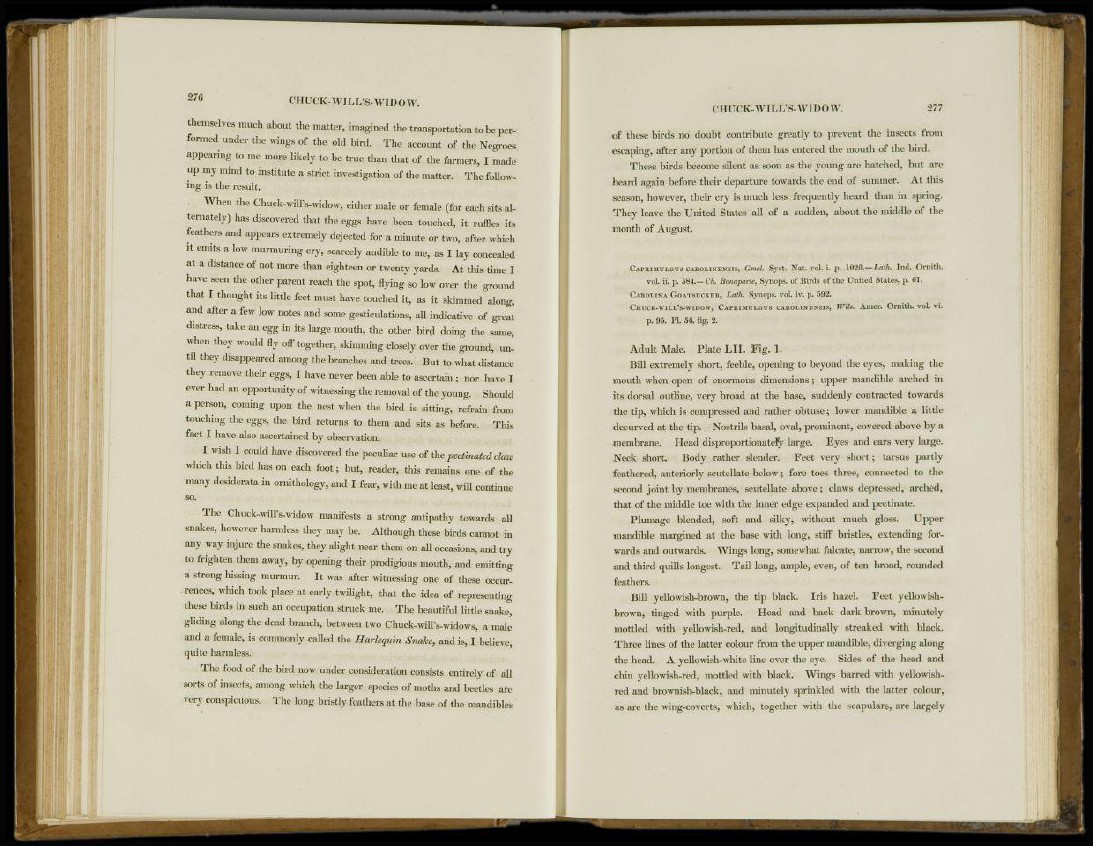
276 CHUCK-WILL'S-WIDOW.
themselves much about the matter, imagined the transportation to be performed
under the wings of the old bird. The account of the Negroes
appearing to me more likely to be true than that of the farmers, I made
up my mind to institute a strict investigation of the matter. The following
is the result.
When the Chuek-whTs-widow, either male or female (for each sits alternately)
has discovered that the eggs have been touched, it ruffles its
feathers and appears extremely dejected for a minute or two, after which
it emits a low murmuring cry, scarcely audible to me, as I lay concealed
at a distance of not more than eighteen or twenty yards. At this time I
have seen the other parent reach the spot, flying so low over the ground
that I thought its little feet must have touched it, as it skimmed along,
and after a few low notes and some gesticulations, all indicative of great
distress, take an egg in its large mouth, the other bird doing the same,
when they would fly off together, skimming closely over the ground, until
they disappeared among the branches and trees. But to what distance
they remove their eggs, I have never been able to ascertain; nor have I
ever had an opportunity of witnessing the removal of the young. Shoidd
a person, coming upon the nest when the bird is sitting, refrain from
touching the eggs, the bird returns to them and sits as before. This
fact I have also ascertained by observation.
I wish I could have discovered the peculiar use of the pectinated claw
which this bird has on each foot; but, reader, this remains one of the
many desiderata in ornithology, and I fear, with me at least, will continue
so.
The Chuck-wiUVwidow manifests a strong antipathy towards all
snakes, however harmless they may be. Although these birds cannot in
any way injure the snakes, they alight near them on all occasions, and try
to frighten them away, by opening their prodigious mouth, and emitting
a strong hissing murmur. It was after witnessing one of these occurrences,
which took place at early twilight, that the idea of representing
these birds in such an occupation struck me. The beautiful little snake,
gliding along the dead branch, between two Chuck-will's-widows, a male
and a female, is commonly called the Harlequin Snake, and is, I believe,
quite harmless.
The food of the bird now under consideration consists entirely of all
sorts of insects, among which the larger species of moths and beetles are
very conspicuous. The long bristly feathers at the base of the mandibles
of these birds no doubt contribute greatly to prevent the insects from
escaping, after any portion of them has entered the mouth of the bird.
These birds become silent as soon as the young are hatched, but are
heard again before their departure towards the end of summer. At this
season, however, their cry is much less frequently heard than in spring.
They leave the United States all of a sudden, about the middle of the
month of August.
C A P R I M U L G U S C A R O L I N E N S I S , Gmel. Syst. Nat. vol. i. p. 1028.—Lath. Intl. Ornith.
vol. u. p. 584.— Ch. Bonaparte, Synops. of Birds of the United States, p. 61.
C A R O L I N A G O A T S U C K E R , Lath. Synops. vol. iv. p. 592.
C H U C K - W I L L ' S - W I D O W , C A P R I M U L G U S C A R O L I N E N S I S , Wits. Amer. Ornith. vol. vi.
p. 95. PL 54. fig. 2.
Adult Male. Plate L I I . Fig. 1.
Bill extremely short, feeble, opening to beyond the eyes, making the
mouth when open of enormous dimensions; upper mandible arched in
its dorsal outline, very broad at the base, suddenly contracted towards
the tip, which is compressed and rather obtuse; lower mandible a little
•decurved at the tip. Nostrils basal, oval, prominent, covered above by a
membrane. Head disproportionately large. Eyes and ears very large.
Neck short. Body rather slender. Feet very short; tarsus partly
feathered, anteriorly scutellate below; fore toes three, connected to the
second joint by membranes, scutellate above; claws depressed, arched,
that of the middle toe with the inner edge expanded and pectinate.
Plumage blended, soft and silky, without much gloss. Upper
mandible margined at the base with long, stiff bristles, extending forwards
and outwards. Wings long, somewhat falcate, narrow, the second
and third quills longest. Tail long, ample, even, of ten broad, rounded
feathers.
Bill yellowish-brown, the tip black. Iris hazel. Feet yellowishbrown,
tinged with purple. Head and back dark brown, minutely
mottled with yellowish-red, and longitudinally streaked with black.
Three lines of the latter colour from the upper mandible, diverging along
the head. A yellowish-white line over the eye. Sides of the head and
chin yellowish-red, mottled with black. Wings barred with yellowishred
and brownish-black, and minutely sprinkled with the latter colour,
as are the wing-coverts, which, together with the scapulars, are largely